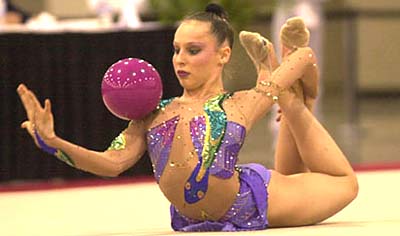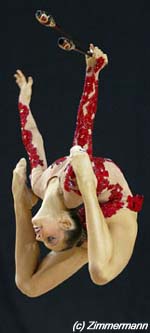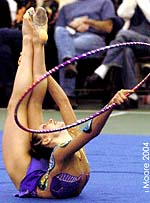Deutsch Englisch
03. Februar 2004
USA
Rhythmic Gymnastics
ATHLETE SPOTLIGHT: Rhythmic Gymnast Olga Karmansky
 |
|
Olga Karmansky (USA) |
U S Olympic Committee: --She has four second-place all-around finishes at the U.S. Gymnastics Championships, a silver medal in all-around from the 2003 Pan American Games and has been consistently ranked second in the United States, but Olga Karmansky is hardly a household name.
Read a portrait of Olga, by the US Olympic Committee...
Read a portrait of Olga, by the US Olympic Committee...

(c) photo: usa-gymnastics
Olga Karmansky, a rhythmic gymnast, has placed second at the U.S. National Championships every year since she began competing at the senior level in 2001, first finishing behind Jessica Howard and then Mary Sanders.
With Sanders and Howard both retired, Karmansky is the frontrunner to inherit America’s rhythmic gymnastics crown. The 18-year-old from Brooklyn, N.Y. is prepared to pick up where Sanders left off.
With Sanders and Howard both retired, Karmansky is the frontrunner to inherit America’s rhythmic gymnastics crown. The 18-year-old from Brooklyn, N.Y. is prepared to pick up where Sanders left off.
 |
“[I want] to compete really well internationally, to hold up Mary’s standings and placements that she made last year and just help the U.S. raise higher and higher [in the international standings].”
That task has not always been easy in a sport that has long been dominated by gymnasts from European countries.
“Competing in Europe is just awesome because the audience knows what rhythmic is all about,” Karmansky said. “So many people come to watch…and they’re just so enthusiastic.”
Americans are more familiar with the flips of artistic gymnastics than with the five apparatus of rhythmic gymnastics: rope, hoop, ball, clubs and ribbon. Rhythmic gymnasts must create a routine set to music that incorporates constant movement of the apparatus with dance. It requires an immense amount of flexibility. Ballet plays a large role in their training. Karmansky said she believes there are misconceptions about rhythmic in America, mainly that it’s looks much easier than it is. “It actually takes a lot of effort and we train 40 hours a week to get good at it,” she said. “And it’s an Olympic sport.”
That task has not always been easy in a sport that has long been dominated by gymnasts from European countries.
“Competing in Europe is just awesome because the audience knows what rhythmic is all about,” Karmansky said. “So many people come to watch…and they’re just so enthusiastic.”
Americans are more familiar with the flips of artistic gymnastics than with the five apparatus of rhythmic gymnastics: rope, hoop, ball, clubs and ribbon. Rhythmic gymnasts must create a routine set to music that incorporates constant movement of the apparatus with dance. It requires an immense amount of flexibility. Ballet plays a large role in their training. Karmansky said she believes there are misconceptions about rhythmic in America, mainly that it’s looks much easier than it is. “It actually takes a lot of effort and we train 40 hours a week to get good at it,” she said. “And it’s an Olympic sport.”
In the U.S., the rhythmic program is on the rise.
At the 2003 World Championships Sanders finished eighth in the all-around qualifying competition and Sanders, Karmansky and Lisa Wang placed 10th as a team, both record high finishes for the United States. Sanders’ ranking qualified the USA to send one athlete to the 2004 Olympic Games. Only countries with athletes that finish in the top-five automatically receive two berths for the Olympics. Sanders then finished first at the 2004 U.S. Olympic Trials, taking the one available spot.
At the 2003 World Championships Sanders finished eighth in the all-around qualifying competition and Sanders, Karmansky and Lisa Wang placed 10th as a team, both record high finishes for the United States. Sanders’ ranking qualified the USA to send one athlete to the 2004 Olympic Games. Only countries with athletes that finish in the top-five automatically receive two berths for the Olympics. Sanders then finished first at the 2004 U.S. Olympic Trials, taking the one available spot.
 |
If Karmansky wants her shot at the Olympics she will have to wait until the 2008 Games in Beijing when she will be 22. The more than three years before the next Games are an eternity in a physically demanding sport such as rhythmic gymnastics.
“That would be awesome if my body could stand the workouts and everything that long,” she said. “That would be really great, but I’m just taking everything day by day, competition by competition and just seeing where it takes me.”
On Feb. 13 Karmansky will compete at the Rhythmic Challenge in Colorado Springs, Colo. The event serves as the annual re-ranking for the Junior and Senior National Teams. Following the Challenge are several Grand Prix competitions that will keep her in the gym training.
“That would be awesome if my body could stand the workouts and everything that long,” she said. “That would be really great, but I’m just taking everything day by day, competition by competition and just seeing where it takes me.”
On Feb. 13 Karmansky will compete at the Rhythmic Challenge in Colorado Springs, Colo. The event serves as the annual re-ranking for the Junior and Senior National Teams. Following the Challenge are several Grand Prix competitions that will keep her in the gym training.
Karmansky currently trains twice a day Monday through Friday, with Tuesdays off, and once a day on Saturdays and Sundays. Her practice schedule varies with her competition schedule. She will cut back a few practices if no events are coming up or her coach wants her to rest.
Her gym, Nova Athletics, is a five-minute walk from her house in Brooklyn. Karmansky switched to Nova in 2003 to help ease the financial burden on her parents, whose sacrifices have not gone unnoticed by their daughter.
“They’ve done everything they could for me,” she said. “They’ve put aside everything that has to do with them. They’ve put all their money and energy into me and I’m so grateful and thankful for all the support they’ve given me for 10 years.”
How much longer that level of support will be required is uncertain. Karmansky has aspirations beyond gymnastics and college lies in the near future. Her plan is to enroll in January 2006, but nothing is final, she said. She recently took the SAT and is contemplating possible majors.
“I’m still vacillating between about five things,” she said. “I want to be a court lawyer, but then I’m also thinking about other things like a broadcast journalist [or] something in public relations.”
Author: Angela Pinder, U.S. Olympic Committee
Her gym, Nova Athletics, is a five-minute walk from her house in Brooklyn. Karmansky switched to Nova in 2003 to help ease the financial burden on her parents, whose sacrifices have not gone unnoticed by their daughter.
“They’ve done everything they could for me,” she said. “They’ve put aside everything that has to do with them. They’ve put all their money and energy into me and I’m so grateful and thankful for all the support they’ve given me for 10 years.”
How much longer that level of support will be required is uncertain. Karmansky has aspirations beyond gymnastics and college lies in the near future. Her plan is to enroll in January 2006, but nothing is final, she said. She recently took the SAT and is contemplating possible majors.
“I’m still vacillating between about five things,” she said. “I want to be a court lawyer, but then I’m also thinking about other things like a broadcast journalist [or] something in public relations.”
Author: Angela Pinder, U.S. Olympic Committee


 *... back to
*... back to














